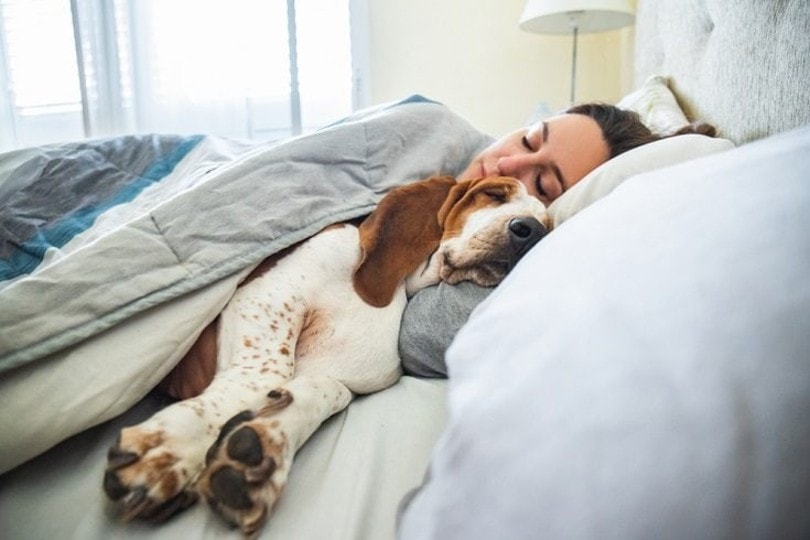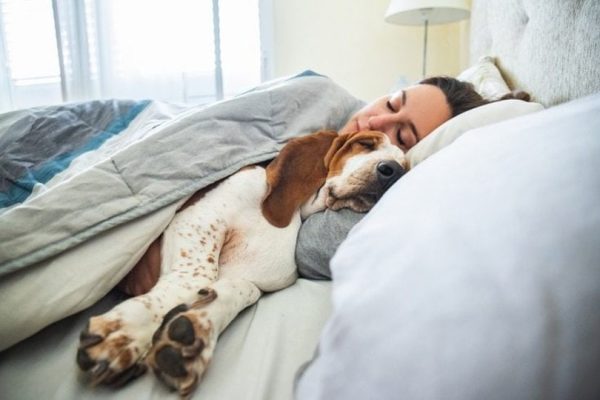We all love our dogs, and they love us. For such cuddly, extroverted creatures, it’s no wonder our dogs often want to soak up every scrap of affection they possibly can, even when they are sleeping. It is no surprise that many dogs in America spend their nights cuddling up next to their owners. But how many? And what are the pros and cons of this? To learn more, keep reading.
How Many Dogs Sleep with Their Owners?
According to a study by the American Pet Products Association, 43% of dogs sleep in bed with their owners.1 That’s nearly half of all dogs in America! So, if your dog cuddles up to you at night, you are in good company.
The same survey also discovered that the numbers differ between small-breed, medium-breed, and large-breed dogs that sleep with their owners. Only 32% of large-breed dogs sleep in their owner’s beds. For medium dogs, the number is 41%. Small-breed dogs make up the largest portion of dogs sleeping in the same bed as their humans at 62%.

Pros and Cons of Sharing a Bed with Your Pet
Like most things in life, there are downsides and benefits to sharing a bed with your dog.
- One of the benefits of sleeping next to your dog can be seen throughout human history: sharing body heat. Research has indicated that Indigenous Australians often slept beside their pets to share and conserve body heat.
- Another reason to share a bed with your pet is to combat loneliness. People who sleep beside their pets often report that they feel a sense of calm and companionship when their dog is next to them.
- Sleeping beside your beloved pet can help you cope with trauma-related sleep issues. For instance, those suffering from post-traumatic stress disorder may struggle to feel safe when they try to sleep or frequently wake from nightmares. In these instances, having a trusted companion at your side can be a soothing presence. Research has found that 57% of veterans with post-traumatic stress disorder consider service animals to be helpful in alleviating their sleep issues.
- An unfortunate aspect of sharing a bed with your dog is the potential for spreading allergens and diseases. If you already have an allergy to dogs, this can be quite a significant downside, as the increase in allergens will only make your allergy symptoms worse. Likewise, zoonotic diseases are also easily transferred from your dog to you when in close proximity.
- Another con to be aware of is the possibility of accidental injury. If your dog wakes up disoriented or frightened, it may lash out at you on instinct.
How to Get Your Dog to Stop Sleeping in Your Bed
If your dog sleeping in your bed is less than desirable, you may be looking for ways to break this habit. Dedicated training is one of the best ways to guarantee that your dog learns to stay out of bed, although this will require lots of patience and time.
One way to train this behavior out of your dog is to buy a dog bed. Tell your pet to get off your bed each time it climbs on and direct it to the dog bed. Then, reward your dog when it stays in its own bed. It may take several weeks for your dog to learn to sleep in its own bed.

If you enjoy sharing a bed with your dog, you will want to ensure that you do so as safely as possible. Creating boundaries is the first step to safely sharing a space with your dog. Only allow your dog on your bed when you invite it. Make sure your dog has its own bed to sleep in during nights you do not share.
- Stand firm against aggressive behavior. If your dog grows territorial over the area, it may become aggressive. Any time it displays aggression, command it off the bed and do not let it back up.
- Keep your dog above the blankets. If your dog accidentally gets tangled in the sheets, it may panic and lash out due to fear. This can lead to accidental injury of your dog or others in the bed.
- Make sure that you practice good grooming. If your dog is well-groomed, it will keep your bed relatively clean. But if your pet is poorly groomed, you may be exposed to loose hair, dirt, debris, and possibly fleas.
In Conclusion
Sharing a bed with your dog can be a great way to bond, and there are plenty of other benefits. However, issues may arise if your dog is not properly trained to accept boundaries and avoid aggression. Be sure to observe proper safety precautions to keep yourself and your dog safe and happy.
Featured Image Credit: Daniel Myjones, Shutterstock












